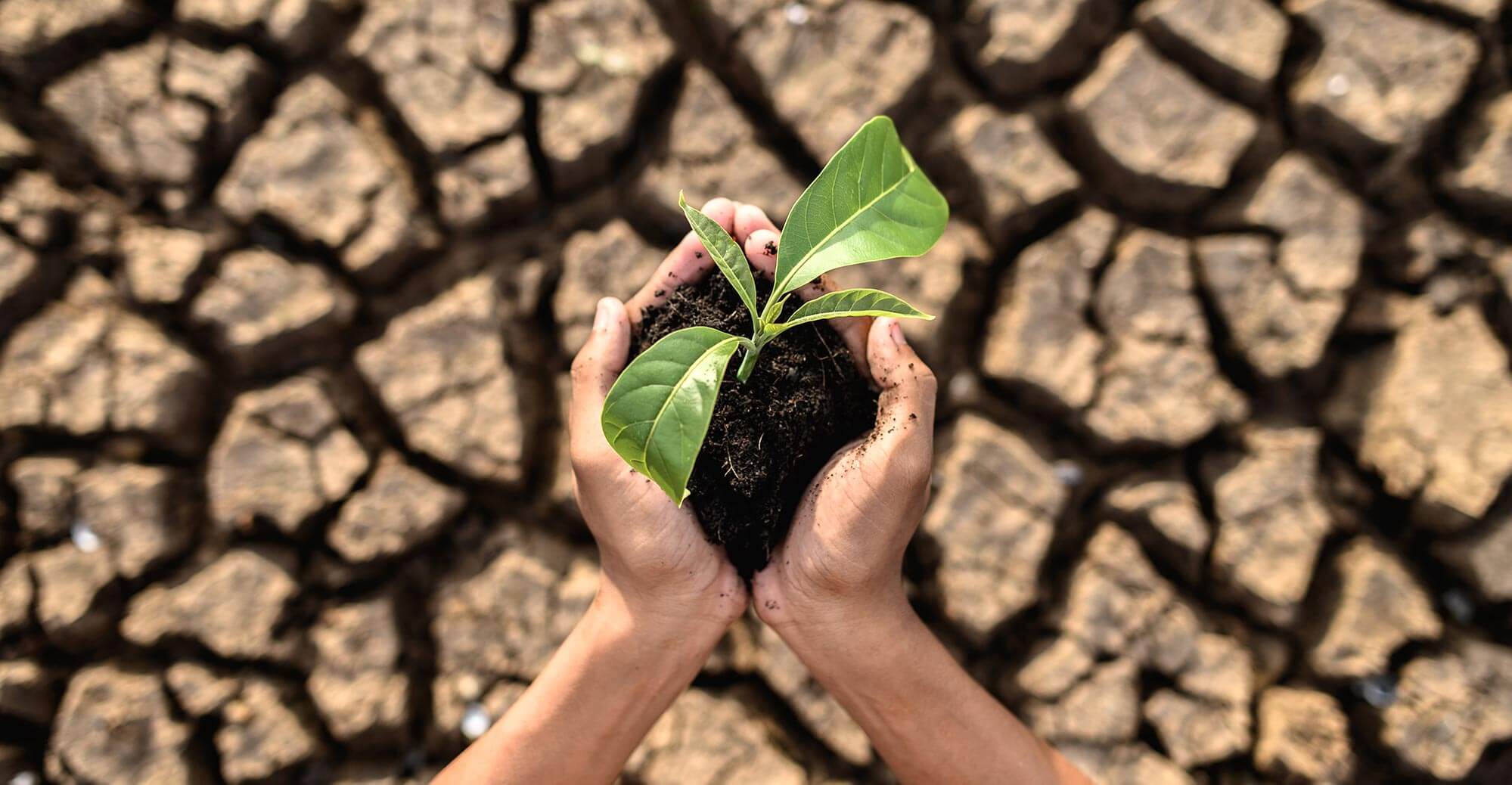The fact that climate change has already had major, dramatic consequences on the lives of billions of people around the world is not something that requires extensive documentation. The greenhouse effect has been well-known and well understood since the 1960s and the global scientific committee established under the aegis of the UN to monitor the phenomenon (the Intergovernmental Panel on Climate Change, or IPCC) has been in operation since 1988. Having said that, what rapid global warming will actually mean over the decades to come has not yet been widely and fully understood. Over the recent years, diaNEOsis has been actively involved in this matter, publishing a study on the effects of climate change in Greece and a series of articles and essays, and also organizing or participating in numerous events to make all aspects of the phenomenon better understood. In the 2017 study, a team of researchers coordinated by professor Costas Kartalis from the National and Kapodistrian University of Athens analyzed in detail the consequences of climate change in 53 areas of Greece, dividing the country into 50 km x 50 km "squares". The researchers then analyzed the consequences of climate change in each of those areas in the middle of this century and then outlined how those consequences will affect various sectors of the Greek economy. The findings were of great interest.
Read The Entire Study (Ιn Greek)
In their new study, Prof. Kartalis' team takes the analysis to the next level: this time they divided the country's territory into squares measuring 12.5 x 12.5 km, which comes to about 850 different land areas nationwide. They then took three of the scenarios developed by the IPCC about how greenhouse gas emissions will develop in the future, and examined what those changes will mean for 21 different climate indicators in each of those 850 areas of the country for each of those scenarios and for two different twenty-year time periods: 2026-2045 and 2046-2065. Thanks to this analysis, they were able to record for this set of climate parameters and indicators and the combination of climate models, the most accurate estimates available for climate conditions in Greece in the coming decades, depending on whether mankind will manage to limit greenhouse gas emissions or not.
Researchers then evaluated exactly what the prevalence of such conditions means for three sectors of economic and social activity -the agricultural sector, tourism, and life in cities-, and proposed policy solutions for each case. They also analyzed the current situation in the energy and transport sectors, the reforms needed by Greece's statutory framework to cope with these new conditions, and also analyzed the state of emissions per Greek resident, giving us an indication of how much each and every one of us contributes to the problem.
You can read the entire study here (in Greek).
You can find some of the key data and central conclusions from the study below. But first, it is worth mentioning some basic facts about the phenomenon of climate change.
1. Why is the climate changing?
The term "climate change" was initially coined to refer to any change affecting the global climate and extending over long periods of time (30 years or more). Today, however, the term is mostly used to describe the gradual rise of the planet's temperature observed steadily over the past 150 years. The reason behind this phenomenon is the greenhouse effect: as gases like CO2 or methane gather in the atmosphere at increasingly higher levels, more of the Earth's radiation remains trapped in the lower atmosphere, therefore causing the temperature to rise.
It is true that, across different geological periods, the total proportion of this type of gases present in the atmosphere has always been subject to fluctuations resulting from natural processes. In the past, there have been periods when the concentration of greenhouse gases in the atmosphere was much higher than today. The planet was much warmer then. The main difference between then and now, however, is that this time around the temperature is rising much faster, and there are humans living on the planet. Never before in the history of mankind have CO2 concentrations exceeded 300 parts per million (ppm).
The Impact of Climate Change on the Greek Economy (in Greek)
In 1860, this figure was as low as 286 ppm. As the years went by, however, human activity and the adoption of various new and increasingly intensified processes (combustion of fossil fuels for energy production, intensive agriculture and livestock farming, etc.) resulted in the gradual release of increasingly higher percentages of CO2 and other greenhouse gases —for example, methane and nitrous oxide— into the atmosphere. By 1970, CO2 concentrations were recorded at 326 ppm. In 2000, the figure exceeded 370 ppm; nowadays, it has reached 414 ppm. This is the highest concentration of greenhouse gases observed in the Earth's atmosphere in over 3.5 million years. This means that humanity has never lived on a planet as warm as ours is today.
As previously mentioned, in the late 1980s the international community set up an international scientific committee which, operating under the aegis of the UN, was tasked to monitor the phenomenon, provide forecasts and suggest possible courses of action. Since then, the Intergovernmental Panel on Climate Change (IPCC) has published six major reports and has significantly optimized its climate change forecasting models (the forecasts they produced during the 1990s and in the year 2000 about today's climate were proven accurate —in fact, the present situation is a confirmation of their worst-case scenarios). Using these models, the IPCC is currently developing a series of alternative scenarios endeavoring to predict the possible development of greenhouse gases concentrations. The latter will take into account a variety of factors, including population growth, economic growth, energy consumption, renewable energy generation, technological advancements, deforestation, as well as possible land-use changes.
Three of these scenarios were used while preparing this study. In specific:
- RCP 2.6 is the most optimistic scenario. According to RCP 2.6, the Earth's population peaks at around 9 billion in the middle of the century, with the numbers beginning to decrease right afterward. The use of fossil fuels declines very rapidly, and greenhouse gas emissions levels already start to decline in 2020 (it would appear we have already missed that mark), reaching net-zero by 2100. In this scenario, the concentration of CO2 in the Earth's atmosphere will peak at 442 ppm in 2050 but then fall back to 421 ppm by 2100, while there will be a 2-degree rise in the average temperature by 2100 as compared to the average temperature during pre-industrial times. This, more or less, is near the objective of the Paris Agreement. As things stand today, the likelihood of this scenario coming to pass is almost zero. The IPCC is preparing a new optimistic scenario, visibly more pessimistic than the optimistic RCP 2.6.
- RCP 4.5 is an intermediate scenario. According to that, greenhouse gas emissions peak at around 2045 for CO2 and around 2050 for methane, and then plunge quite dramatically. Large areas of land are reforested and meat consumption declines. In this scenario, the CO2 concentrations in the Earth's atmosphere reach 487 ppm in 2050 and 538 ppm by 2100, while the global average temperature shows a 3-degree rise by 2100. As a result, many animal and plant species will not be able to survive, while human societies will be severely affected.
- RCP 8.5 is the worst-case scenario. In essence, the IPCC uses RCP 8.5 to depict what will happen if nothing is done. According to this scenario, greenhouse gas emissions produced from human activity continue to increase throughout the century. The CO2 concentrations in the atmosphere reach 541 ppm in 2050 and a whopping 936 ppm in 2100. At the same time, there is a 5-degree increase in the global average temperature by 2100 (in certain areas), which exerts tremendous pressure on every ecosystem on the planet.
As mentioned above, diaNEOsis' study looks at the consequences of climate change in almost 850 areas across Greece, examining how 21 different climate indicators would evolve over the 20-year periods 2026-2045 and 2046-2065, if each one of the three IPCC scenarios were to materialize.
Let's have a look at the conclusions.
2. Greece in the near Future
For most human activities, atmospheric temperature is the single most important factor climate change will affect. For individual sectors, however, other indicators emerge as equally important. Agriculture and livestock farming, for example, are also severely impacted by rainfall, extreme weather phenomena, drought, and soil erosion. All these factors are mutually dependent, and it is expected that the impending climate changes will influence them all. In turn, these factors affect agricultural and livestock production through processes that are manifold and complex, ranging from the availability of water resources and soil fertility to the appearance of parasites and diseases. The fact that we will be experiencing longer periods of warm weather on a yearly basis; that extreme weather phenomena will occur more often; that increasingly more areas will be affected by dry spells and that flooding will be more common will certainly play a very important role. This research did not simply look at standard climate parameters but also examined more complex indicators, developed specifically in order to give us a more complete, comprehensive picture of how the situation will affect each area of Greece. For the purposes of this study, the researchers investigated how 21 different climate parameters and indicators will be affected. They then examined what those indicators tell us about potential pressures exercised in specific areas and sectors of activity, namely agriculture/livestock farming, tourism, and urban living.
In this specific study, the scope extended beyond the 20-year period 2046-2065 to also include the years 2026-2045, while the period 1971-2000 served as a reference point for comparisons.
For the vast majority of climate parameters and geographical areas examined, the consequences of climate change in Greece are negative, although they are not always of the same intensity. Their effect on different parameters or areas of the country presents variations. For example, the average temperature in the wider Athens conurbation in the period 1971-2000 was 15.6 °C. That number alone does not tell us much. However, what we need to concern ourselves with is how it is expected to evolve under the different scenarios—reaching around 17 degrees under the best scenarios and 18 degrees if the worst-case scenario comes to pass.
Other examples can even look positive at first glance. In the period 1971-2000, the wider area of Ioannina experienced on average about 31 days of frost per year (the total number of days when the minimum daily temperature does not exceed zero degrees Celsius). If the 'optimistic' (yet very unlikely) RCP 2.6 scenario comes to pass, over the next 40 years the average number of days of frost will be around 19 days per year. In the intermediate scenario, we will have 12 days of frost annually, within the next 25 years. In the worst-case scenario, Ioannina will only have 5 days of frost a year by the middle of the century.
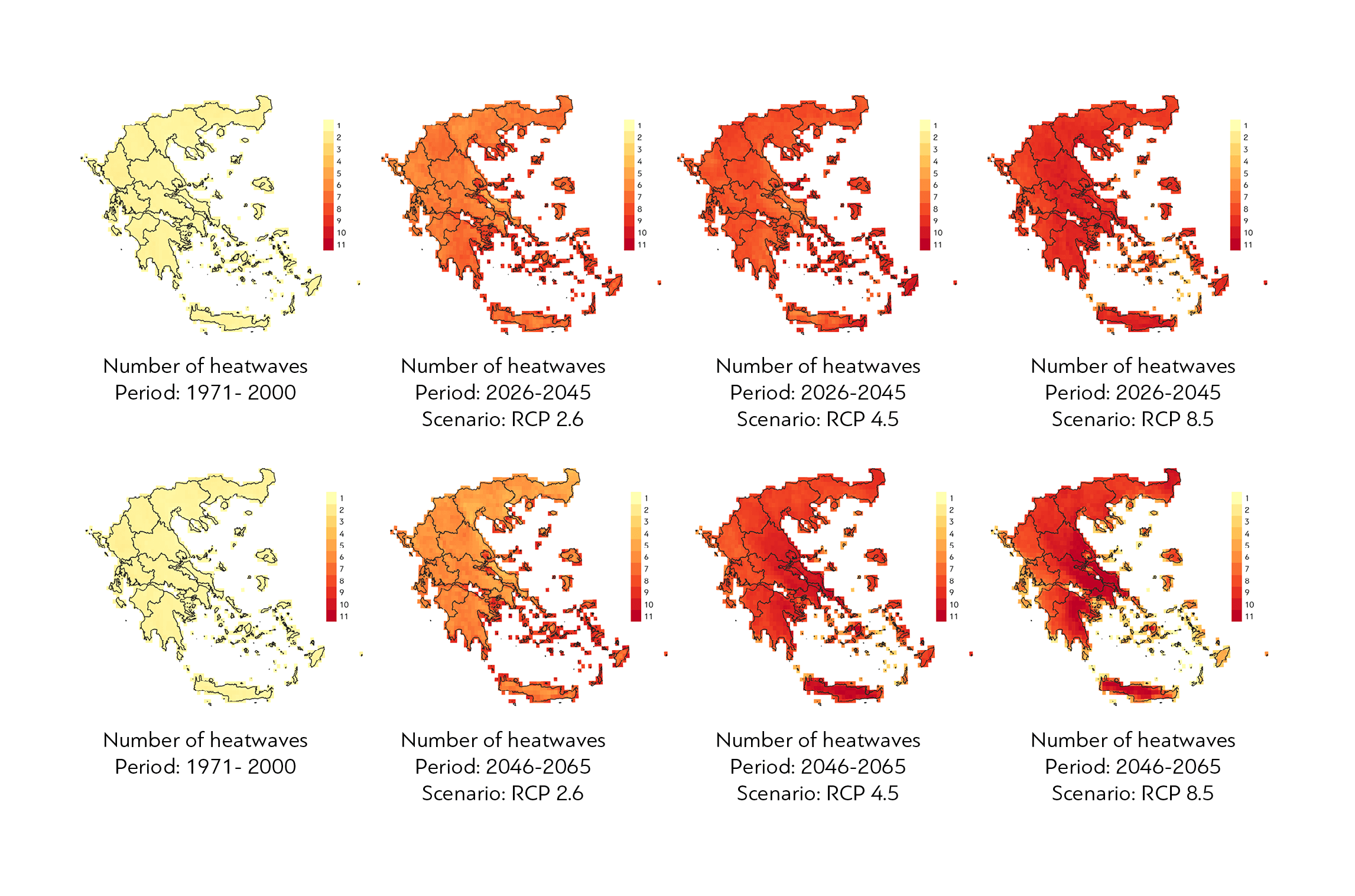
Overall, conditions are expected to take a turn for the worse. As we know from our previous study, by the year 2050 it is estimated that the number of days when Greece will be hit by heatwaves will increase by 15-20 days per year; rainfall levels will drop by 10% at best and 30% at worst; the number of days with high risk of fire will see an increase between 15% and 70%; and extreme weather phenomena will be much more frequent. Overall, if the 'good' scenario (RCP 2.6) applies, the temperature will rise by around 2 degrees by the middle of the century. If the intermediate RCP 4.5 scenario comes to pass, the figure may climb to 2.5-degrees, while in the nightmare RCP 8.5 scenario mainland Greece will be warmer by 3.4 degrees. As the researchers pointed out, "the country is becoming increasingly warmer and drier, with extreme weather phenomena which will be more intense, more frequent and longer-lasting".
Let's look at the consequences this will have in the three sectors examined in the study.
3. The Agricultural and Livestock Sectors
An interesting finding one would certainly not expect to read in this kind of study is that the consequences of climate change in the primary sector are in fact not solely negative. One potentially positive effect is that, as researchers consistently report, there will be an extension of the growing season which will benefit the cultivation of certain crops. In some areas, the cultivation of specific crops will be either expanded or emerge as a new opportunity (increased temperatures generally benefit cotton plantations). In addition, areas previously considered unfit for cultivating specific varieties of wine will now become suitable. "The estimated extension of the growing season will bring about an improvement of the growing conditions throughout Greece", the researchers note, "while it is likely that the total surface of cultivable areas will increase". Moreover, in all scenarios, the risk of losing crops to frost is lower.
Sadly, though, the good news ends here. Most of the consequences will undoubtedly be negative. In all scenarios, there is reduced rainfall across the country, soil moisture decreases (especially in the spring) and there are more periods of drought and a number of days with very high temperatures in all areas of Greece. In Larissa and Thessaloniki, it is estimated that crops will be significantly affected by extreme weather conditions.
The consequences will not be uniform across the country. Most crops and livestock farming will be affected negatively, especially in Crete (Heraklion) and the regions of Ileia, Corinth, and Larissa. On the contrary, Evros, Fthiotida, and Aetolia-Acarnania will be among the areas suffering the least consequences. The fragility and behavior of each crop are also expected to bear upon the outcome. For example, olive trees are exceptionally resistant to drought and high temperatures, so in theory they could withstand even the most intense consequences of climate change. However, the fact that in winter it will be less cold —low temperatures are necessary for the olive blossom to develop fully— could have a negative impact on olive tree production. The productivity of vineyards will also be affected, as will the ratio of sugars and acids in the product itself —ultimately altering the taste and quality of wine produced in all areas of the country. In addition, fodder crop cultivation will experience reduced performance and higher water requirements.
What, however, could be done to mitigate these pressures? During this study, the researchers focused on eight of the most important agricultural and livestock production areas in the country (Aetolia-Acarnania, Thessaly, Fthiotida, Ileia, Evros, Heraklion, Thessaloniki, and Corinth). They mapped the current production, evaluated the challenges which will arise in specific areas and for specific crops in the near future, and proposed targeted measures. The unwavering conclusion is that growers must take into account the forthcoming changes and adjust their crops and methods accordingly. It is pivotal to pay particular attention to water management and ensure irrigation efficiency, which at present has not been optimized (many areas of the country are already facing serious problems). Ιn this direction, diaNEOsis has already published a study (in Greek) which discusses the local land improvement organisations (TOEB) and the general land improvement organisations (GOEV) as well as the practices of the various farmer cooperatives managing irrigation waters, and proposes a new management model which could render these organisations viable.
Crop diversification and rotation, selecting crops which are better adapted to the new climate conditions in each area, cultivating crops under shaded areas or in greenhouses, and applying carefully targeted drainage of agricultural lands (to reduce soil erosion and ease the impact of flooding) are also necessary measures the primary sector needs to implement in order to adapt to the new situation.
Lastly, the climate challenges lying ahead provide yet another argument in favour of shifting the attention towards 'precision agriculture', as it has come to be known, which relies on contemporary techniques and technologies (ground sensors, GPS and remote surveillance tools used to monitor the production). Ιn any event, researchers stress that these interventions need to be accompanied by campaigns to raise awareness among growers and livestock farmers about the impact of climate change on their work, and about the tools which have been developed to help them counter the effects.
4. Climate Change and Cities
The phenomenon known as 'Urban Heat Islands' refers to the fact that urban areas experience higher temperatures than outlying areas and is determined by urban density, the availability of natural ventilation, the type of human activities pursued in the area as well as the total surface of available green spaces. Within the wider Athens area, the resulting difference in temperature is estimated at 8 or 10 degrees.
This tells us a lot about the extent of pressure which will fall on Greek cities in the coming period —it will be much greater, to be sure, than in the countryside. For this reason, it is essential to thoroughly study the impact of the impending changes specifically on the cities.
In the period to come, for example, all areas of Greece will be experiencing heatwaves a lot more frequently. "Heatwaves" are defined as the days of the year when the temperature exceeds a limit that is unique to each area but is at the 90th percentile for the reference period. In the period 1971-2000, the number of heatwaves recorded at the centre of Athens averaged 1.4 per year. Even with the best scenario, over the next 25 years this figure will rise to an average of 6, while with the middle scenario by the middle of the century Athenians will be living through more than 9 heatwaves per year.
Moreover, the average temperature will rise everywhere, but more so in Patras, Kalamata and Athens. In the most pessimistic scenario, the average temperature over the summer months in Patras and Kalamata will rise by more than 3 degrees. In Athens, the increase will exceed 2 degrees no matter what scenario comes to pass, which is very serious indeed.
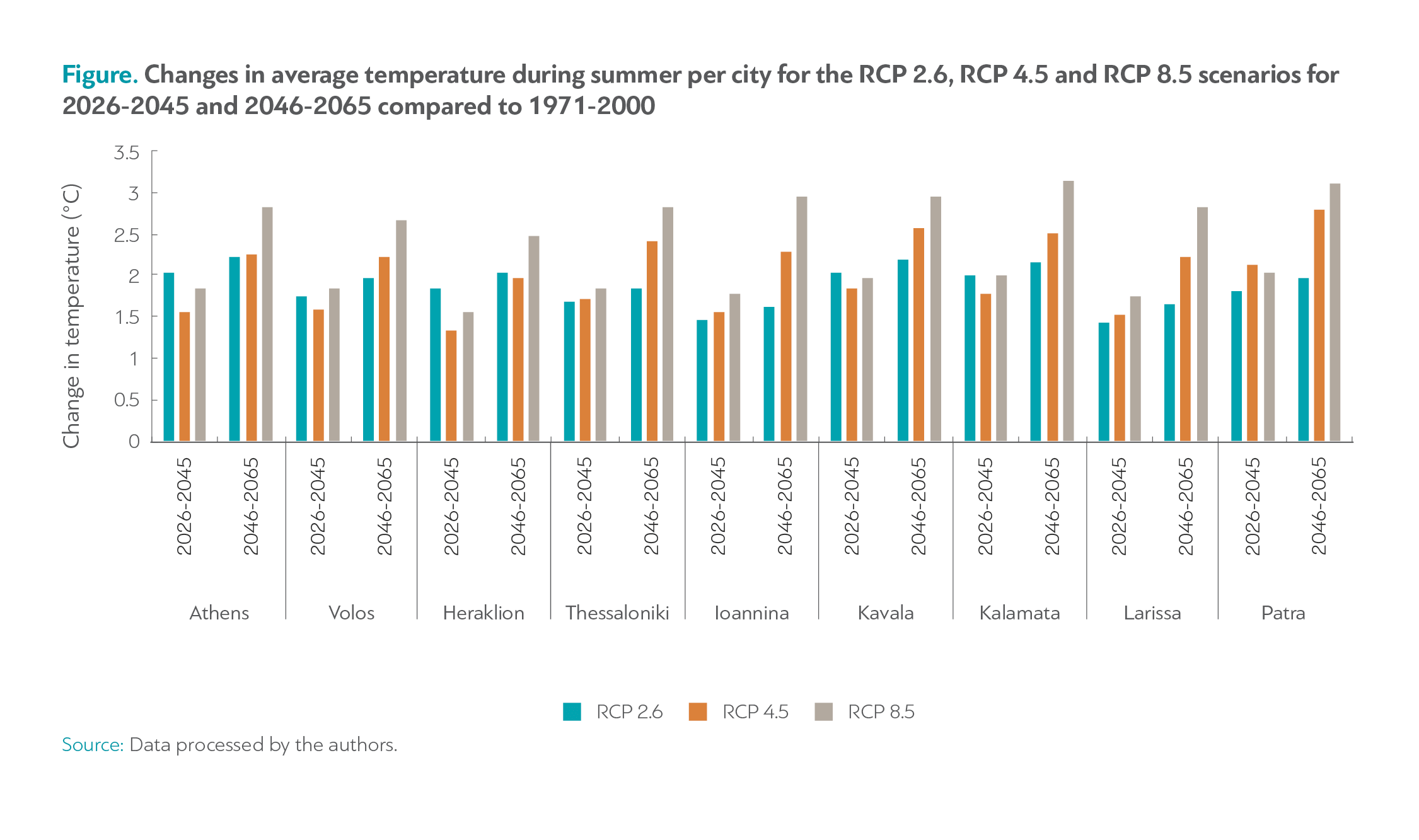
In areas such as Athens, Thessaloniki and Larissa the number of days when the maximum temperature exceeds 37 degrees will rise considerably. The same is true for the so-called 'tropical nights' (when the temperature does not fall below 20 °C at night). This is particularly important, as the index is linked to increased rates of mortality and cardiovascular diseases—these are the nights during which buildings do not have the time to cool down. Moreover, western Greek cities such as Patras and Ioannina will experience a lot more days with heavy rainfall, resulting in a higher risk of flooding.
The problem is not merely that cities will be warmer and more vulnerable. It is estimated that by the middle of the century everywhere in Greece people's cooling needs will double; and even though at the same time the country's heating needs will decline (especially in coastal areas and on the islands) the overall energy needs are expected to spike.
So what could be done so that Greek cities may adapt to these exceptionally difficult conditions? What is certain is that, at present, cities are far from prepared and that extensive measures will need to be taken in the years to come. Among other actions, the researchers propose a redesign of 'Exoikonomo', the energy saving program currently ran by the Greek state to support citizens with their home energy saving transformations. The researchers propose that the criteria for allocating the program's funds also take into account the extent of thermal exposure (i.e., how exposed citizens are to high temperatures due to the age of the buildings they live in, the higher density of heat sources, the lack of green spaces, etc.) instead of being solely income-based, as is the case today. As a further measure, the research team recommended to revise the Building Energy Performance Regulations as well as employing other tools which could prove effective especially when targeted at the right areas, such as setting specific goals for municipalities (e.g., reducing greenhouse gas emissions by 2030), pedestrianising roads and converting others into low-traffic roads. Creating green roofs on public and private buildings can also help reduce a city's ambient temperature, while the development of urban (small or medium-sized) parks within the urban fabric is extremely beneficial. In a recent 2019 study (in Greek) diaNEOsis stressed precisely this need, while various European cities, for example Paris and Barcelona (the study discusses specific interventions implemented in these cities), are developing networks of small parks using already existing open spaces such as school playgrounds. In our study, the researchers examined how that could be applied to Greek schools, taking as an example the 144th Primary School of Athens in Sepolia and evaluating what would be the effect in the area's microclimate if a series of interventions were carried out at that specific building and its schoolyard. Their findings show that a series of interventions —including the creation of a green roof, the installation of reflective materials in the forecourt and planting in the playground— would lead to a 1 to 3-degree temperature drop at the school's indoor and outdoor premises, while the ensuing positive effect would extend much further than the confines of the school's courtyard, stretching up to an 80 to 100-meter radius. As our researchers pointedly stated, if such interventions were made in all schools across the Municipality of Athens, their 'cooling effect' would cover 8 square kilometers. That is, almost 20% of the total surface occupied by the Municipality of Athens.
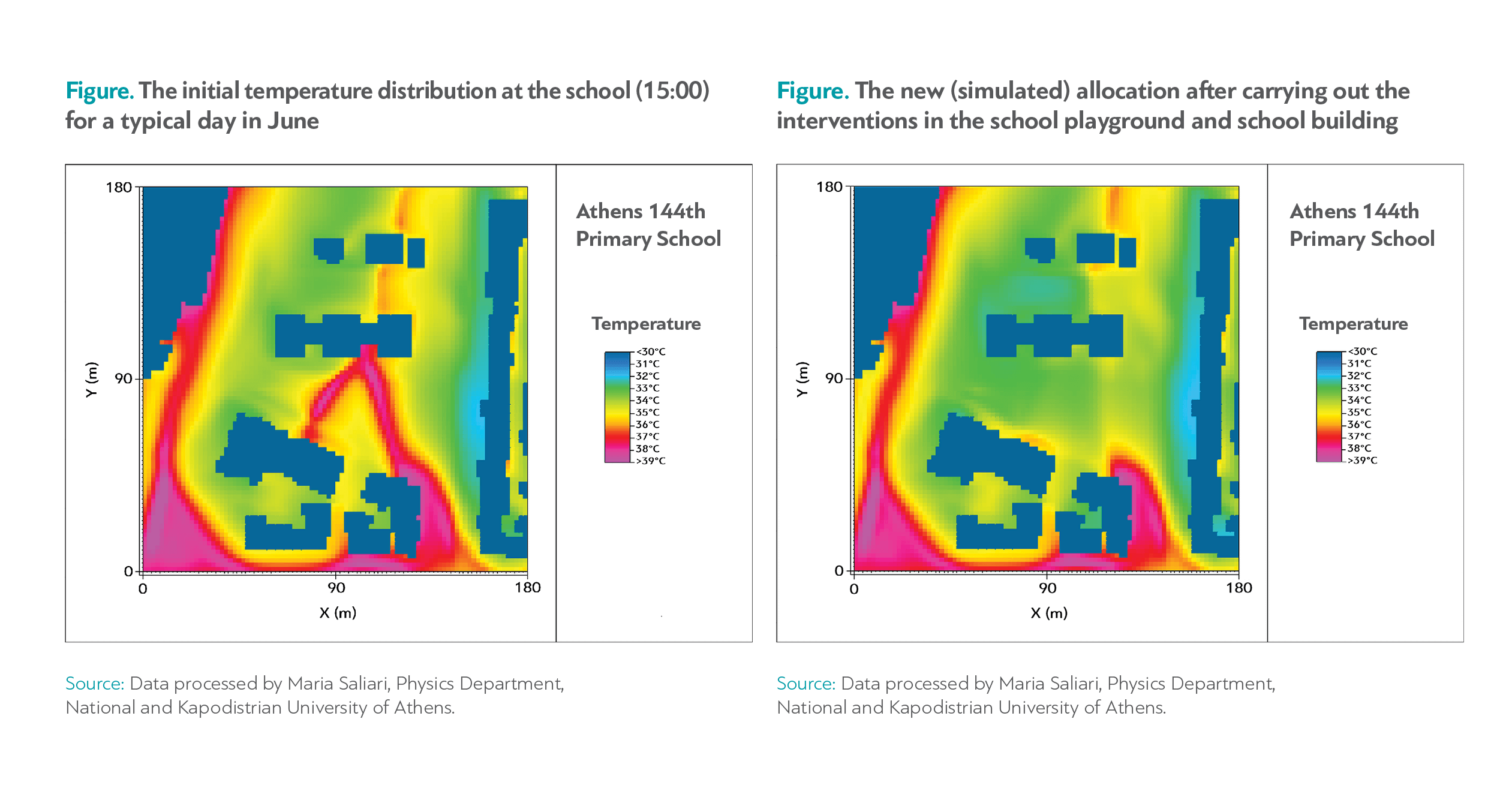
Such interventions could generate tremendously important benefits. It is worth remembering that if the ambient temperature in Athens were to drop by even one degree, this would lead to a 4.1% reduction in energy consumption for cooling, a reduction in photochemical gaseous pollutants by around 7-8%, as well as an 8% drop in the number of deaths caused by lung and heart diseases (especially when the temperature climbs over 40 degrees).
5. Tourism and Climate Change
As already pointed out in an earlier study, a superficial reading of the data presented to us by the climate indicators could lead to the conclusion that climate change could have a positive impact on tourism in Greece, given that it is likely for the tourist season to be extended. Summer could well be lasting from May to September, and that is something that will happen relatively soon. At the same time, however, the fact that heatwaves are becoming more frequent will degrade the experience of millions of tourists visiting Greece in the summer. Areas such as Halkidiki, Rhodes, Crete and the islands of the Argosaronic region will be seeing many more hot days during the summer. In addition, 'tropical nights' (nights where the ambient temperature does not fall below 20 degrees) will be a far more frequent occurrence throughout Greece but above all in the western coastline, the Ionian Islands, Western Peloponnese and Central Macedonia [if the worst-case scenarios are confirmed, this list will be extended to include Crete, Evia, Eastern Macedonia and Thrace (on the coast) as well as other areas]. Heatwaves (incidents with very high temperatures and absence of winds which span more than 3 consecutive days) will be a lot more frequent across the country and the change in temperature may lead to a further shortening of the already brief skiing season, making the operation of ski centers in Greece unviable. Landscaping work has already commenced at some of them (by removing rocks) to allow the pistes to operate with less snow.
But there may be further consequences at stake: extreme weather conditions may be hitting Greece more frequently, there could be changes in the landscape due to rising sea levels, disrupted biodiversity and increased cooling costs for the tourist sector.
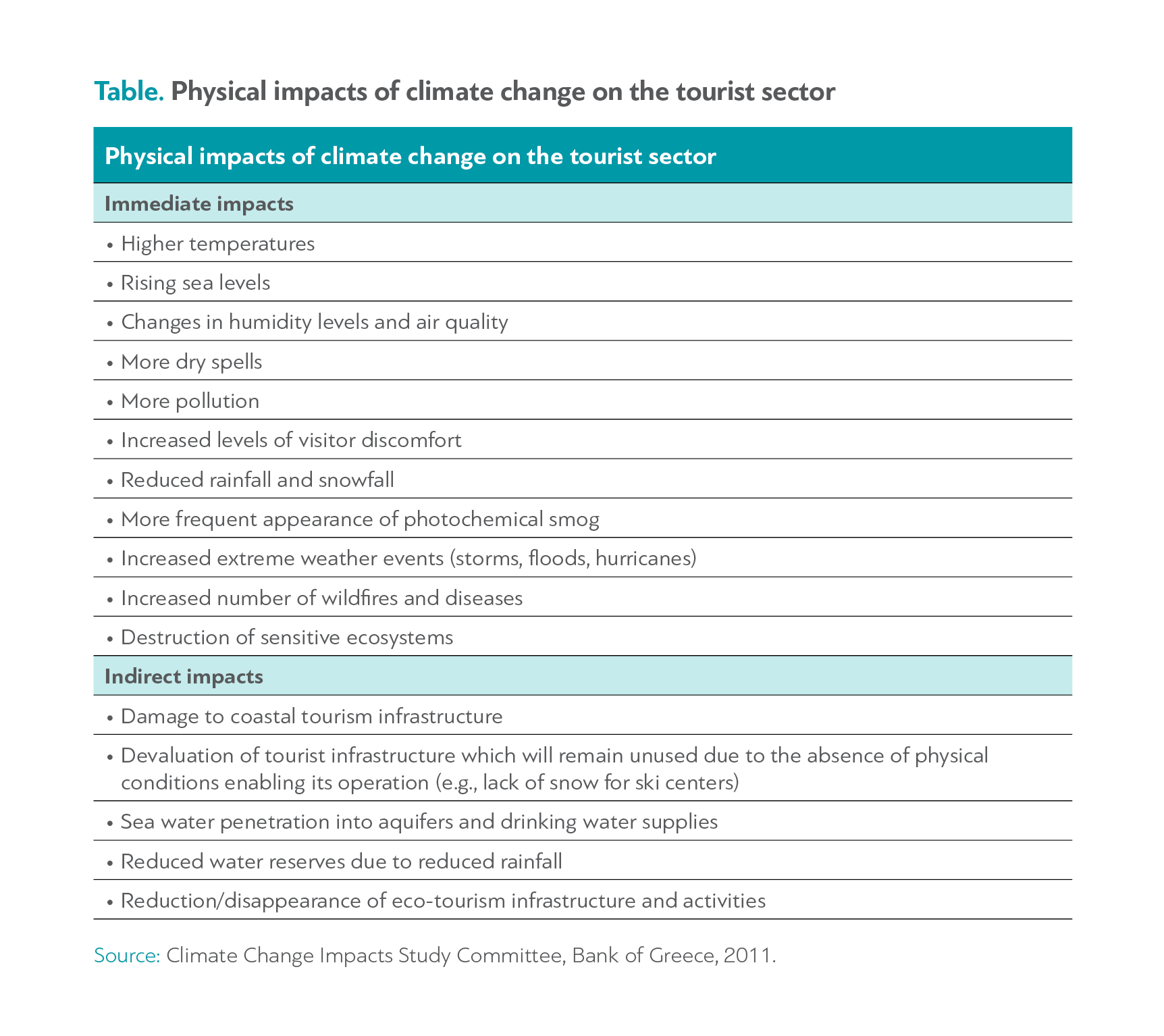
Aiming to study the phenomenon as thoroughly as possible, the researchers selected 91 tourist areas which they divided into three categories depending on their level of development: highly developed (such as Mykonos, Santorini, Rhodes, Hersonissos near Heraklion); mildly developed (Monemvasia, Nafplio, Syros); and developing (Karpathos, Aidipsos, Kythira and Paxi). According to the study's data, if the worst-case scenario comes to pass, by the middle of the century in 52 of those areas the temperature will rise by more than 2.5 degrees Celsius compared to the 1971-2000 period.
The solutions proposed to adapt the sector to these conditions include 14 operational plans, ranging from developing spatial planning (which should take into account changes in climate conditions) and energy infrastructure for popular tourist destinations; ensuring that the infrastructure is resilient to extreme weather conditions; building flood defenses; and adapting tourist cultural resources.
6. Energy and us
The biggest part of the study is concerned with finding ways to facilitate the adaptation of various sectors of life and economic activity to the new, and to some extent unavoidable, climate conditions. Another part of it, however, is devoted to an examination of possible strategies that could help mitigate these new weather conditions. In the fifth chapter of the study, the researchers tackle the issue of energy, which was already the subject of another specialized study recently published by diaNEOsis.
It is worth noting at this point that Greece is not a big greenhouse gas emitter: only 0.18% of global emissions are generated locally (but given that Greeks represent 0.13% of the world's population, we still emit a little more than our share). In fact, in 2019 Greece released 20% less greenhouse gases compared to 1990. As already analyzed at length, this drop was largely due to the economic crisis that shook the country during the decade 2010-2020, though it can also be partly attributed to the rapidly increasing significance of renewable energy sources (RES) in Greece's energy mix.
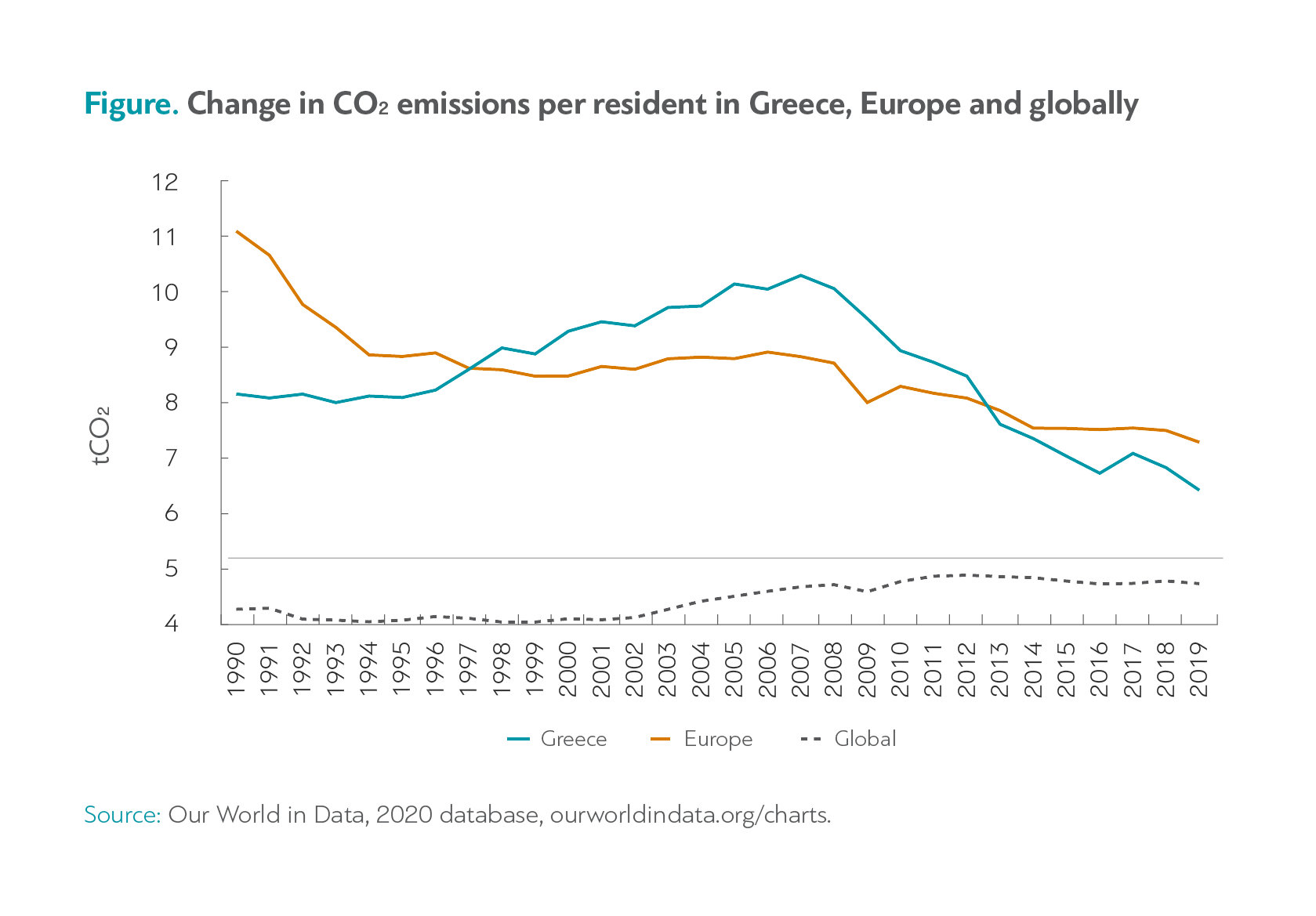
The energy production and consumption sector have perhaps the lion's share in the generation of greenhouse gas emissions. To be sure, there are other high-emitting sectors, such as industrial production, construction, the agri-food industries, and many other processes as a result of which a considerable amount of greenhouse gases is released into the atmosphere. It is, however, certain that without significant transformations in the energy sector there is no chance of achieving any of the ambitious targets set by states, meaning that the worst scenarios will unavoidably come to pass.
According to the analysis presented in the study, RES are already mature and cheap enough to be an important part of the solution. Due to low wind speeds, this year the wind turbine contribution was smaller than usual, but all IPCC scenarios stipulate that up to the 20-year period 2046-2065 the allocation of Greece's wind capacity will remain unaltered. The Aegean Sea, in particular, is seen as an ideal location for developing offshore wind farms, especially considering the interconnecting networks currently being developed in the area (a recent article on the subject, (in Greek) can be found here). Moreover, regarding the energy sector the researchers stress that it is expedient for improvements in the energy efficiency of buildings to be accelerated; for the passenger car fleet to be swiftly replaced; for oil-based heating systems to be gradually replaced and for smart electricity meters to be installed in buildings as quickly as possible. These are all necessary steps if we are to achieve the targets which have been set by the EU and adopted by Greece. It should be noted, though, that we are still a long way from achieving these targets. The European Green Deal foresees the development of 100 climate-neutral cities in Europe by 2030. According to the researchers, as things stand, the likelihood of a Greek city joining that group within less than 9 years is very low.
Finally, the researchers turned to examine another important and interesting factor: the amount of greenhouse gases emitted by each resident of Greece depending on his/her activity. This information is all the more topical, since a big part of the public discussion on climate change is centered on changes or adjustments the citizens could or should make in order to reduce their own footprint. In the course of this study, an attempt was made to record exactly what this 'footprint' is, whether it can be reduced with mild or painless interventions and, of course, whether it makes sense for individual citizens to get involved in such a process.
According to the study, the average emissions per Greek citizen is presently calculated at 7 tons of CO2 per year. If the EU target of achieving a 55% drop in emissions by 2030 is to be reached, we will need to emit around 3 tons per person. A large part of this change will need to take place through changes over which we have no control. For example, a considerable part of our individual share of emissions (almost 10%) comes from electricity consumption at home. This means that if the energy we consume is produced using cleaner methods, the per capita emissions will be dramatically reduced. That is something which, barring any accidents, is going to happen: lignite will soon vanish from the energy mix to be in part replaced by natural gas which has lower greenhouse gas emissions; at the same time, the increased use of RES will bring down the levels of CO2 needed to help us keep the lights on longer. Some other activities, however, depend more on our own behavior. Whether we eat a lot of meat or just a little (at every stage, meat production releases immense quantities of greenhouse gases into the atmosphere) or whether we replace our home's oil-burning heating system (which accounts for 6-7% of our emissions) with a heat pump also affects our footprint. But the change with the greatest impact on our footprint seems to be how we choose to move around. The use of petrol or diesel cars and air travel are responsible for up to half of the CO2 emissions allocated to each one of us. Imagine that the amount of CO2 a four-member family releases by using its car for a year is approximately equal to that generated by the household's yearly electricity consumption. A citizen who flies from Athens to Thessaloniki and back four times a year releases 1.28 tons of CO2 equivalent from these trips alone —these emissions could be reduced to 0.28 tons of CO2 equivalent if the person was traveling by train.
Table 15 of the study presents an indicative scenario of greenhouse gas emissions generated by a single member of a 4-member household. This is useful in that it can give us an idea of how our daily activities affect the phenomenon.
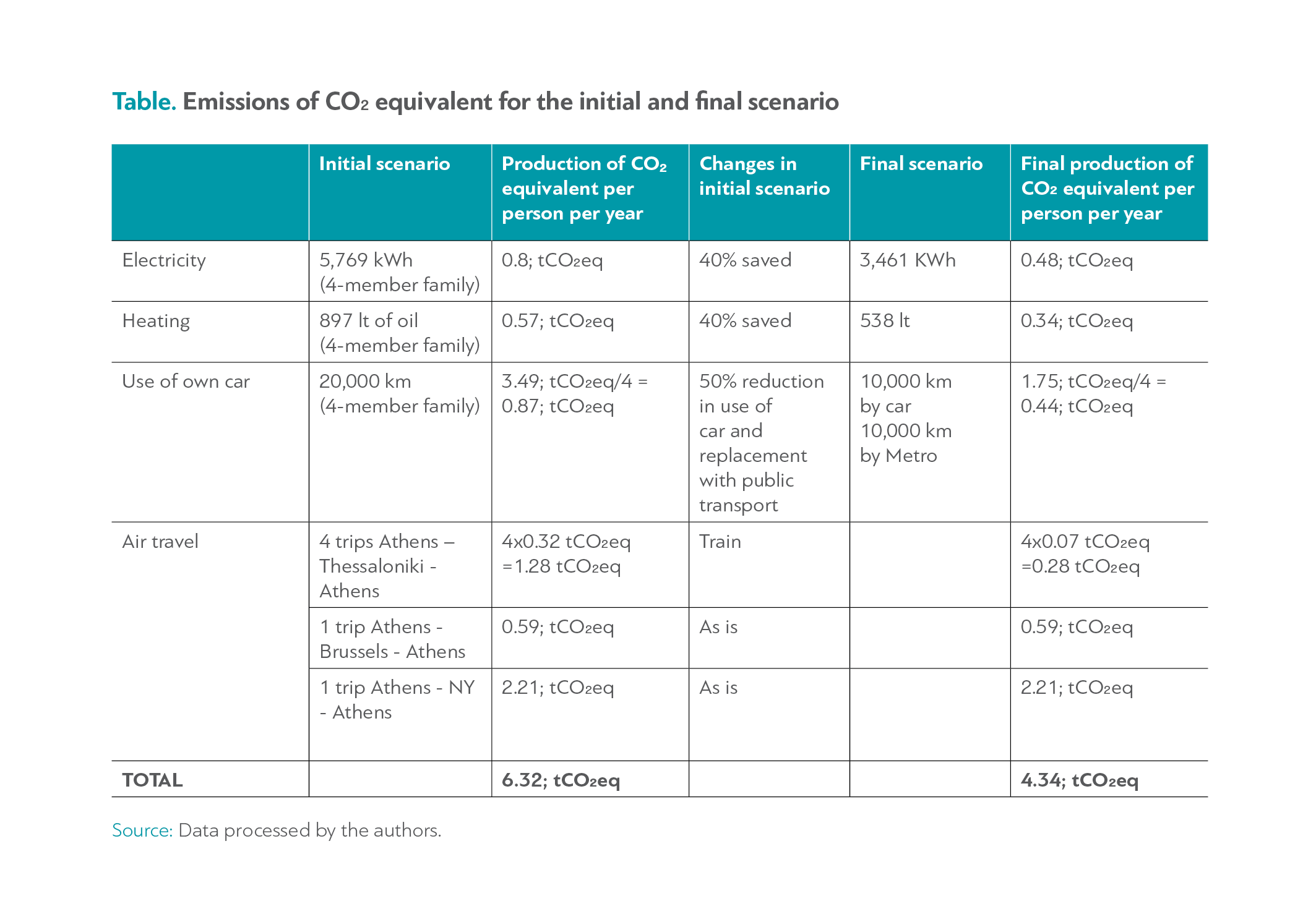
Ιt should be noted here, however, that citizens who reduce their consumption of meat or use public transport more frequently could never singlehandedly solve the climate change problem. The impact each one of us makes is minimal and, indeed, negligible in the face of emissions generated by the energy, construction, and livestock farming sectors or certain other sectors of industry. And the changes which will mitigate the problem in these areas can only come from the states, for they are the only entities in a position to plan and impose them. It turns out that the most important thing citizens can do (more important than flying less frequently) is to push their governments in the right direction to implement solutions such as those included in this study.
7. Horizontal Solutions and Hope
In addition to the individual solutions proposed in the various chapters of the study, the researchers point out that climate change should be placed at the centre of an overall revision in Greece's statutory framework, which would cover everything from the regional planning frameworks and water management plans to local planning schemes in all areas of the country. There is also a horizontal need to improve energy efficiency in all sectors of activity, from industry to buildings, so as to reduce the overall energy needs (thus making it easier to meet demand and ensure energy efficiency after the end of lignite); to prepare management plans for the protection of agricultural production (especially in Central Macedonia and Thessaly); and to come up with plans aimed at helping tourist areas already facing climate change—or expected to be more heavily afflicted in the coming decades—adapt to the new situation. Furthermore, it is necessary to integrate climate change as a parameter in the planning of all major new infrastructure (from bridges and airports to hotels and marinas) whose lifespan is normally measured in decades. As we saw above, in a few decades the conditions will be substantially different.
All this needs to be done so that Greece's infrastructure, economic activity, and social cohesion may be shielded against the impending changes. The adjustments required (and the corresponding degree of difficulty) will depend on which scenario will finally come to pass. Will we have to live in a world warmer than today but still manageable? Or —as is most likely the case— in a world much warmer than today, and with much more intense phenomena? Neither individual citizens nor individual small states can truly influence the answer to this question. The only way forward in order to come up with a solution is the international cooperation between the world's largest countries. Steps are already being taken in this direction. The EU and Greece have committed to achieve a 55% drop in emissions by 2030 and gradually reach net zero by 2050. Whether Greece and other countries, will manage to meet their goals is something that remains to be seen.
